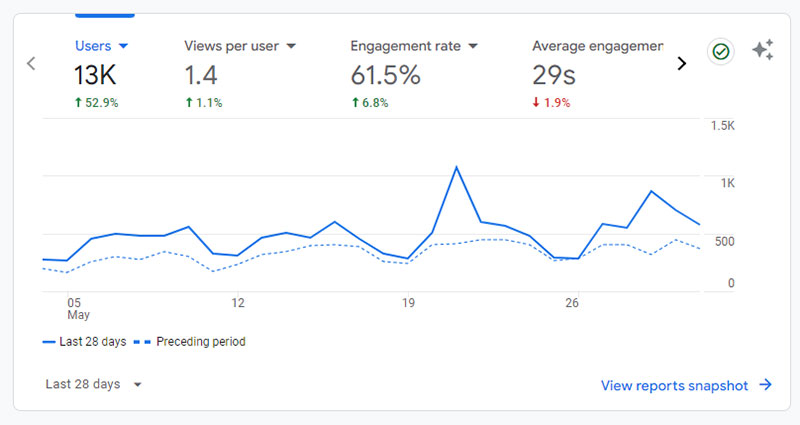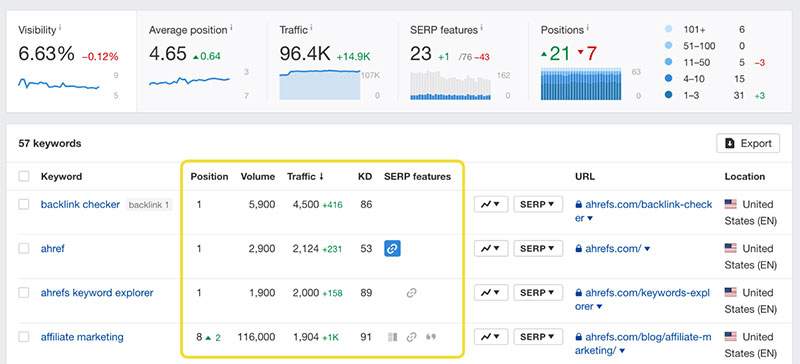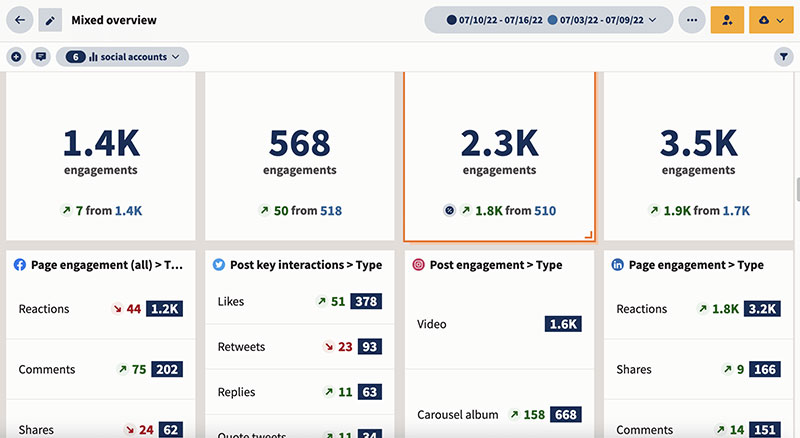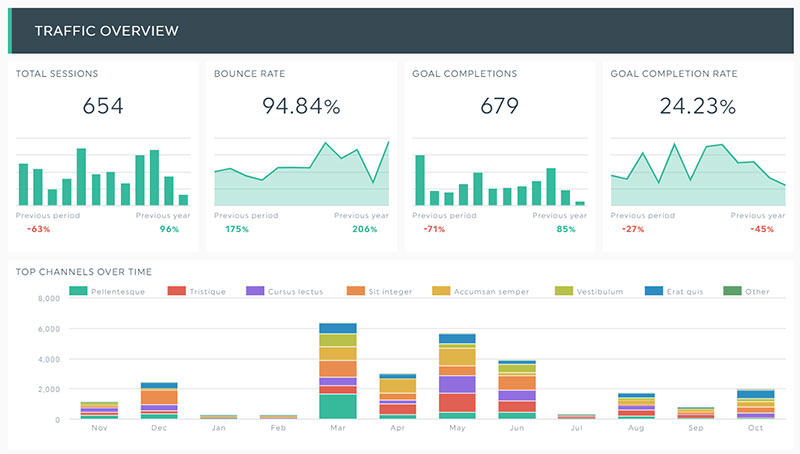Ever wondered why some content skyrockets while others flounder in obscurity? The secret sauce often boils down to understanding and tracking the right content marketing KPIs.
Knowing your audience engagement figures, conversion rates, and ROI impacts your strategy in profound ways.
These aren’t just fancy metrics but essential tools to dissect your content performance, refine your tactics, and ultimately, boost customer retention rates.
Whether you’re using Google Analytics, HubSpot, or Adobe Analytics, these tools are pivotal in transforming raw data into actionable insights.
In this guide, I’ll peel back the layers of crucial KPIs you should focus on. By the end, you’ll be armed with an arsenal of knowledge on how to measure content success effectively, track social media metrics, and ultimately, maximize your digital marketing efforts.
Laced with examples and insider tips, this journey through KPI mastery promises to elevate your content game.
Content Marketing KPIs
| KPI | Description | Goal | Measurement Method | Tools |
|---|---|---|---|---|
| Website Traffic | Number of visitors to the website | Increase audience reach | Page views, unique visitors | Google Analytics, SEMrush |
| Engagement Rate | Interaction level with content (likes, shares, comments) | Enhance audience engagement | Engagement actions per post | Social media platforms, BuzzSumo |
| Conversion Rate | Percentage of visitors taking a desired action | Improve lead generation and sales | Conversions / total visitors * 100 | Google Analytics, HubSpot |
| Bounce Rate | Percentage of visitors leaving after viewing one page | Improve content relevance and quality | Single-page visits / total visits * 100 | Google Analytics |
| Social Media Reach | Number of unique users who saw the content | Expand brand awareness | Number of unique viewers | Social media analytics tools |
| Email Open Rate | Percentage of opened emails | Enhance email marketing effectiveness | Opened emails / total sent emails * 100 | Mailchimp, Constant Contact |
| Lead Generation | Number of leads generated from content | Increase potential customer base | Total number of leads | HubSpot, Marketo |
| Customer Acquisition Cost | Cost of acquiring a new customer | Optimize marketing spend | Total marketing spend / number of new customers | Financial tools, Google Analytics |
| Return on Investment (ROI) | Revenue generated from content marketing efforts | Evaluate overall effectiveness | (Revenue – Cost) / Cost * 100 | Financial tools, Google Analytics |
Traffic KPIs
Website Traffic
Organic Traffic

Imagine a bustling marketplace, but in the digital realm. That’s organic traffic for your website.
It’s visitors arriving naturally, primarily through search engines rather than paid advertisements.
For a thriving content marketing strategy, organic traffic is gold. It signifies your content is engaging, with strong keywords and SEO practices in place.
Page Views
Ah, page views—the simple measure of how many times a single page on your website is loaded. But it’s more than just numbers.
Each view tells a story of interest or curiosity, crucial for understanding what grabs your audience. Regularly monitoring page views helps you fine-tune your content.
Bounce Rate
Bounce rate is like people walking into a store, taking one look around, and promptly leaving.
It’s the percentage of visitors who navigate away from the site after viewing just one page. High bounce rates? They could indicate irrelevant content or poor user experience.
Time on Page
Time is money, they say. And in the digital content world, the time visitors spend on a page is priceless.
The longer, the better—it means they’re engaging, absorbing information, perhaps even ready to convert. It’s a direct indicator of content quality and relevance.
Pages Per Session
What keeps a user clicking around your site? Pages per session measure this curiosity.
If visitors move from one insightful article to another, it’s a signal—your content is interconnected and engaging.
It encourages deep dives into the treasure trove of information you’ve crafted.
SEO Performance
Keyword Rankings

Where do you stand in the vast Google landscape? Keyword rankings tell you this. It’s like checking your position in an never-ending race.
Tracking these helps refine your strategy, ensuring you’re using the right terms to attract your target audience. Tools like SEMrush and Moz are indispensable allies here.
Backlinks
Think of backlinks as digital endorsements. When reputable sites link back to your content, it boosts credibility and authority.
Not all backlinks are created equal, though. Quality matters. Effective backlinks can drastically improve your site’s ranking, driving more organic traffic and bolstering your SEO metrics.
Engagement KPIs
Onsite Engagement
Comments
Ah, comments.
The lively debate, the heartfelt praise, the occasional troll. They’re the digital echoes of engagement. Each comment is a tiny beacon that says, “I care enough to share my thoughts.”
It’s raw engagement, an unfiltered glimpse into your audience’s mind. A sea of comments means your content is sparking genuine interaction.
Scroll Depth
Ever wondered how far your audience scrolls?
Scroll depth is the journey of your content reader’s digital voyage.
It’s a revealing metric that tells you just how captivating your content truly is. If they’re scrolling to the very end, bravo!
Your storytelling’s magnetic. But if they halt midway, perhaps it’s time to rethink those attention-grabbing hooks.
Social Shares
The holy grail of online validation—social shares. When readers can’t help but spread the word, your content is hitting the right notes.
Shares amplify your reach organically, breeding more engagement and driving traffic back to your site. It’s the viral dream every content creator lives for.
Likes and Shares
A thumb’s up, a heart, a retweet—a simple gesture of approval on social media. Likes and shares are the quick nod of appreciation from your audience.
They don’t have the depth of comments but still indicate that your content has struck a chord. It’s instant, it’s gratifying, and it fuels your digital momentum.
Social Media Metrics
Engagement Rates

Let’s dive deeper than the ubiquitous “likes.” Engagement rates measure the real interaction: comments, shares, and clicks divided by the total views.
It’s the truest barometer of how well your content resonates.
An impressive engagement rate means your followers are not passive scrollers; they’re active participants in your content journey.
Follower Growth
Ah, the sweet ascent of follower numbers. Each new follower is akin to a customer walking into your store, intrigued and willing to listen. But beware the trap of vanity metrics.
A swelling follower count is meaningless without engagement. Quality trumps quantity—always. Organic, engaged followers are the lifeblood of sustainable social media success.
Conversion KPIs
Lead Generation

Number of Leads
Picture a garden brimming with potential—each lead a budding flower. The sheer number of leads is the first step towards a fruitful harvest.
It’s the bedrock of any conversion strategy.
More leads mean more chances to nurture and convert, but sheer volume isn’t everything. It’s only part of the puzzle.
Lead Quality
Not every lead is created equal. Are they genuinely interested, or just curious passersby? High-quality leads mean less time weeding through the crowd and more time cultivating real opportunities.
Engaging content, precise targeting—these are your fertilizers in the garden of lead quality.
Sales
Transactions and Revenue
Cha-ching! The ultimate goal—transactions ringing up and revenue streaming in.
It’s the heart of any business. Each sale isn’t just a number; it’s validation that your strategy works.
Whether it’s a flurry of small transactions or a few high-ticket items, every bit fuels your growth engine.
Conversion Rate
This metric, oh the golden ratio. Conversion rate—the percentage of visitors who take the desired action, be it signing up, buying, or downloading.
It’s telling.
It’s the measure of your site’s efficiency in transforming interest into action. Whether through persuasive content or seamless UX, improving this rate is key.
Goal Completions
From cart checkouts to form submissions, goal completions are those little victories. Each completed goal is a high five from your site’s visitors, signaling that they found what they came for.
They’re the milestones on your path to achieving broader business objectives.
Content Effectiveness
Open and Click-Through Rates (Emails)
The digital equivalent of opening a letter—email open rates. High open rates mean compelling subject lines, relevant content.
But don’t forget click-through rates. That extra click? It’s the reader taking action based on your message, a tiny triumph in the realm of email marketing.
Customer Retention
Keeping them close—customer retention. Once a sale is made, the real challenge is nurturing that relationship.
Returning customers are not just repeat buyers; they’re brand advocates.
Delight them consistently, and they stay loyal, reducing your need to hunt for new leads constantly.
Return Customers
The familiar faces amidst the crowd—return customers. They signify trust, satisfaction, a relationship built on valuable, engaging content.
They come back for more, not just products but the experience. Treat them well, and they become the backbone of your revenue stream.
Reputation KPIs
Brand Awareness
Influencer Mentions
Imagine a digital cocktail party. Instead of clinking glasses, influencers are mentioning your brand. Influencer mentions are like gold nuggets, priceless and substantial.
When an influencer thinks you’re worth talking about, it’s validation on a grand scale.
It catapults your brand into new circles, reaching audiences you never dreamed possible. Think Hootsuite capturing the attention of social media giants.
Share of Voice
Now, step back. Listen closely. Share of voice is the symphony of your brand’s presence compared to competitors. Are you heard amidst the noise?
This KPI measures your slice of the conversation. The larger the share, the more dominant your voice.
Be it through Google Analytics, BuzzSumo, or even digging into insights from SEMrush, this metric tells where you stand.
Sentiment Analysis
Customer Feedback
Let’s peek behind the curtain. Customer feedback is raw, unfiltered truth. A direct line to the heartbeat of your audience. Whether praise or criticism, it’s essential.
This feedback shapes your strategy, helping you tweak and tune your brand’s symphony.
Tools like Salesforce can provide invaluable insights here—think of it as your backstage pass to customer thoughts.
Sentiment Scores
Lastly, sentiment scores. This metric, it’s a fine wine—complex, layered. It dissects feedback, turning raw data into rich insights.
Positive, neutral, negative—each score a note in the overall melody of customer opinion. Sentiment scores help you grasp the mood, the temperament of your audience.
They are the compass guiding your content marketing KPIs, steering your brand toward positivity and growth.
Production and Distribution KPIs
Content Production Metrics
Number of Content Pieces Created
Think of a bustling newsroom. The clatter of keyboards, deadlines looming. How many articles, posts, videos are we churning out?
The sheer volume of content pieces created is our production powerhouse.
Each piece is a cog in the larger machine, every blog post or infographic a potential magnet for organic traffic. It’s BuzzSumo-worthy volume.
Adherence to Publishing Schedules
Now picture this: a metronome, keeping time. Adherence to publishing schedules is all about rhythm and consistency.
Can we stick to our editorial calendar? Regular publishings signal reliability to your audience and search engines alike, boosting SEO performance.
Falling behind? That’s a hiccup in the flow. It’s Moz’s law—inconsistency equals invisibility.
Content Distribution Metrics
Distribution Channels Used
So, we’ve got the goods. How do we get them out there? It’s a multi-lane highway of distribution channels: social media, email newsletters, guest posts.
Facebook, LinkedIn, CRM platforms like Salesforce, each with its own flair and reach.
Every channel is a megaphone to a different crowd. Choosing the right ones defines your reach.
Reach and Impressions
Finally, we enter the coliseum of reach and impressions. How many eyes saw your content? Reach is your broad sweep, the potential audience exposure.
Impressions? The more granular count—each time your content flickers on a screen. It’s the ultimate gauge of visibility, driving home just how far your words, images, and ideas are traveling across the digital landscape.
Google Analytics and Ahrefs can be your eyes here, scrutinizing every detail.
Combining and Analyzing KPIs
Setting SMART Goals for Content Marketing
Specific
Laser focus. That’s what you need. Goals must be specific, not vague aspirations.
Think, “Increase organic traffic by optimizing content for five new keywords this quarter.
It’s measurable, actionable, and targeted. No fluff, just clear direction.
Measurable
Numbers don’t lie. Your goals must scream for metrics. If it can’t be measured, it might as well not exist.
It’s like using Google Analytics without setting up funnels—you’re flying blind.
You see it, you chase it, you track it.
Achievable
Dream big, but stay grounded. Goals should push you, not break you. Achievable is realistic.
If you’re gunning for a 200% increase in a month, you’re setting yourself up for disappointment.
It stretches you, but doesn’t snap you.
Relevant
Here’s where the rubber hits the road. Your goals must align with broader business objectives. Irrelevant goals are distractions. If your primary focus is lead generation, a goal like “Expand blog post word count by 500 words” misses the mark. Keep it tight, keep it relevant.
Time-bound
The clock’s ticking. Goals need deadlines. It’s the difference between “We’ll do this eventually” and “We’ll do this by December 31st.” Time constraints breed focus and urgency. “Launch a content marketing strategy campaign by Q4.”
Using KPIs to Refine Content Strategy
Identifying Successful Content
So, what’s hitting the mark? KPIs tell you. Look at what’s working and why. Maybe your how-to guides are racking up shares, while listicles are falling flat.
Quality trumps quantity.
A deep dive into Google Analytics can reveal these nuggets. HubSpot’s article on Inbound Marketing—a prime example of content that sticks.
Adjusting Strategies Based on KPI Data
Numbers in hand, it’s time to pivot. Data shows you the way. Are users bouncing off specific pages? Tweak the content.
Are emails not getting opened? Revamp your subject lines or re-evaluate your timing.
It’s a dance—test, learn, adjust. Use platforms like SEMrush and Moz to monitor and modify. Stay agile.
Tools for Tracking and Analyzing KPIs
| Tool | Key Features | Pricing | Target Users | Integration Capabilities |
|---|---|---|---|---|
| Google Analytics | Web traffic analysis, conversion tracking, user behavior analysis | Free, with premium options | Businesses of all sizes | Integrates with Google Ads, Search Console, etc. |
| Adobe Analytics | Advanced segmentation, real-time analytics, predictive analytics | Custom pricing | Enterprises | Integrates with Adobe Marketing Cloud, CRM tools |
| Matomo | Open-source, privacy-focused, customizable dashboards | Free, with paid plans | SMBs, enterprises | Integrates with CMSs, e-commerce platforms |
| Mixpanel | Product analytics, user engagement tracking, A/B testing | Free, with paid plans | Product teams, startups | Integrates with data warehouses, marketing tools |
| Piwik PRO | Data privacy compliance, on-premises and cloud options, detailed reporting | Custom pricing | Enterprises, healthcare | Integrates with CRMs, CDPs, data lakes |
The cornerstone, the bedrock. Google Analytics is indispensable for tracking website traffic, user behavior, and countless other metrics.
It’s your virtual microscope into the intricate world of KPIs. Still, there are others you can use.
Social Media Analytics Tools
| Tool | Key Features | Pricing | Target Users | Integration Capabilities |
|---|---|---|---|---|
| Hootsuite | Social media monitoring, scheduling, analytics, team collaboration | Starting at $19/month | SMBs, enterprises | Integrates with Facebook, Twitter, LinkedIn, Instagram |
| Sprout Social | Engagement tracking, sentiment analysis, custom reports | Starting at $99/month | SMBs, enterprises | Integrates with Facebook, Twitter, LinkedIn, Instagram |
| Buffer | Post scheduling, performance analysis, audience insights | Free, with paid plans | SMBs, startups | Integrates with Facebook, Twitter, LinkedIn, Instagram |
| Socialbakers | Content intelligence, influencer marketing, audience analysis | Custom pricing | Enterprises, marketers | Integrates with major social media platforms |
| Brandwatch | Social listening, audience analysis, competitor benchmarking | Custom pricing | Enterprises, agencies | Integrates with CRM tools, marketing platforms |
Data-rich platforms like Hootsuite and BuzzSumo offer deep insights into engagement rates, shares, likes, and follower growth.
They pull back the curtain on social dynamics.
CRM and Email Marketing Platforms
| Tool | Key Features | Pricing | Target Users | Integration Capabilities |
|---|---|---|---|---|
| HubSpot | CRM, email marketing, lead management, sales automation | Free, with paid plans starting at $50/month | SMBs, enterprises | Integrates with CMSs, social media, marketing tools |
| Salesforce | CRM, email marketing, customer service, analytics | Custom pricing | Enterprises | Integrates with various business apps, marketing tools |
| Mailchimp | Email marketing, automation, audience segmentation | Free, with paid plans starting at $9.99/month | SMBs, startups | Integrates with e-commerce platforms, social media |
| Zoho CRM | CRM, email marketing, sales automation, analytics | Free, with paid plans starting at $12/month | SMBs, enterprises | Integrates with Zoho suite, third-party apps |
| ActiveCampaign | Email marketing, marketing automation, CRM, sales automation | Starting at $9/month | SMBs, enterprises | Integrates with CMSs, e-commerce platforms, social media |
From Salesforce to Mailchimp, these platforms offer detailed analytics on customer relationship metrics.
Open rates, click-through rates, lead conversion—every interaction documented and dissected.
FAQ On Content Marketing KPIs
What are content marketing KPIs?
KPIs, or Key Performance Indicators, are metrics that help gauge the success of your content marketing efforts.
They include engagement metrics, conversion rates, and ROI. These numbers show how well your content strategy is working.
Why are content marketing KPIs important?
Knowing your KPIs means understanding what’s working and what’s not. Metrics like customer retention rates and lead generation metrics can guide your strategy, helping you optimize and improve. KPIs measure success and inform adjustments.
How do I choose the right content marketing KPIs?
Select KPIs that align with your business goals. If audience reach is crucial, focus on website traffic.
For lead generation, track conversion rates. Tools like Google Analytics and SEMrush can help you identify the most relevant KPIs.
What tools help track content marketing KPIs?
Tools like HubSpot, Google Analytics, and Marketo offer powerful insights. They help monitor metrics like bounce rate, click-through rate (CTR), and content effectiveness. These platforms let you track and analyze data seamlessly.
How can content marketing KPIs improve my strategy?
KPIs reveal strengths and weaknesses. If your organic traffic is low, adjust your SEO strategy. High page views but low conversion rates? Maybe your CTA needs work. Monitoring KPIs leads to actionable steps.
What are the key content marketing KPIs to monitor?
Focus on metrics like engagement, conversion rates, ROI, and customer acquisition cost.
Don’t overlook social media metrics such as likes, shares, and comments. These provide a well-rounded view of your content performance.
How often should I review my content marketing KPIs?
Regularly. Weekly reviews offer a snapshot, while monthly deep dives give a broader perspective.
Content performance metrics fluctuate, so consistent monitoring ensures you spot trends and make timely adjustments.
What’s the difference between KPIs and metrics?
Metrics are individual data points like page views or bounce rate. KPIs are the critical metrics aligned with your business goals.
They provide context, allowing you to gauge overall success, rather than just raw numbers.
Can KPIs be qualitative as well as quantitative?
Yes. While quantitative KPIs include conversion rates and traffic analytics, qualitative KPIs can involve customer feedback and brand sentiment. Both types provide a fuller picture of your content’s impact.
How do I set realistic KPI targets?
Base targets on past performance and industry benchmarks. Use tools like Google Search Console and Ahrefs for comparative data.
Be ambitious but realistic – setting achievable goals motivates and guides your team.
Conclusion
Understanding content marketing KPIs is the cornerstone for a successful digital strategy. Metrics like conversion rates, audience engagement, and ROI measurement provide the insights necessary to pivot and improve.
Utilizing tools such as HubSpot, Google Analytics, and SEMrush allows us to dissect these numbers, yielding data that drive smarter decisions.
A deep dive into social media metrics gives a broader view, while lead generation metrics and customer retention rates sharpen focus on core performance indicators.
The dynamism of user behavior analysis and the precision offered by SEO entities like Moz and Ahrefs complete the toolkit.
By regularly assessing these KPIs, we’re not just treading water; we’re building a robust, responsive framework that adapts and thrives.
This approach ensures our campaigns are not just successful but also sustainable, constantly evolving with the digital landscape’s demands. Let’s leverage these insights to make our content marketing strategy unbeatable.
If you liked this article about content marketing KPIs, you should check out this article about the benefits of content marketing.
There are also similar articles discussing developing a content marketing strategy, content marketing goals, content marketing personas, and content audit.
And let’s not forget about articles on content audit checklist, how to conduct a content audit, how to create a content plan, and content marketing mistakes.





